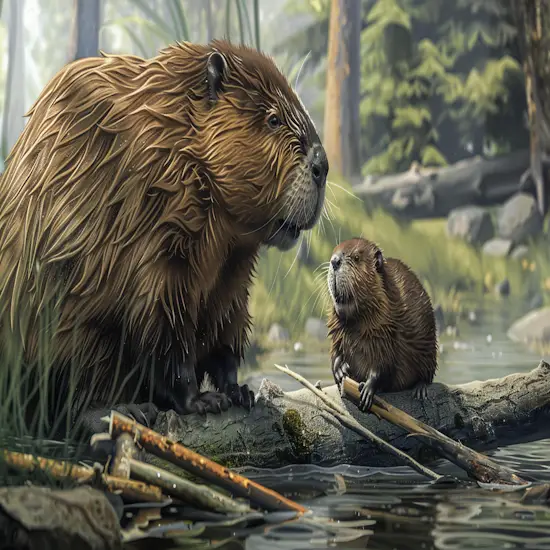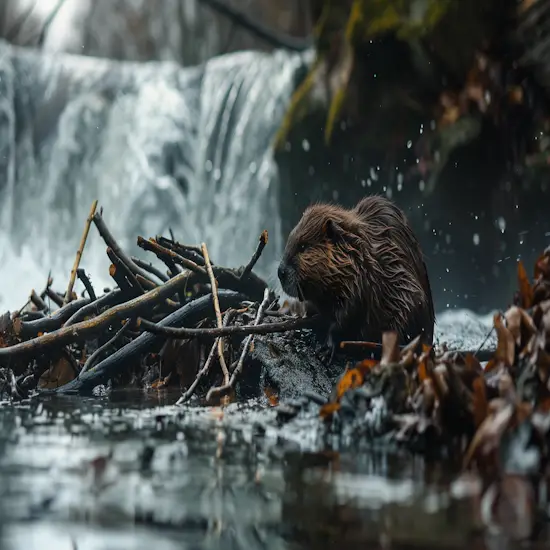Disclosure: We may earn commissions if you purchase products after clicking on a link from our site.
Imagine being a beaver, maneuvering a world where survival hinges on your ability to construct intricate dams. From your innate drive to shape your environment to learning by watching your elders, each aspect of dam-building is a vital piece of your success puzzle. But how do these elements come together in the grand scheme of beaver engineering? How beavers learn to build dams? In this article, this question is answered.

Table of Contents
Key Takeaways
- Genetic predisposition triggers an innate drive for dam construction.
- Maternal guidance teaches essential dam-building skills to young beavers.
- Social learning through observation and imitation enhances dam-building proficiency.
- Trial and error in construction methods leads to skill refinement.
- Environmental factors like water source and tree availability influence dam-building techniques.

Instinctual Behavior
You know, beavers possess a genetic predisposition for building dams, passed down through generations. Additionally, maternal influence plays an important role in teaching young beavers how to construct these intricate structures. These instinctual behaviors are essential for the survival and functioning of beaver colonies.
Genetic Predisposition
Beavers exhibit a genetic predisposition for building dams, showcasing their instinctual behavior in constructing elaborate structures in their habitats. This predisposition is ingrained in their DNA, passed down through generations, guiding them to create dams as an essential part of their survival strategy.
The genetic coding in beavers triggers a natural drive to manipulate their environment by felling trees and using them to block streams, creating ponds that serve as protection from predators and a consistent food source. This innate ability to construct dams is a fundamental aspect of beaver behavior, allowing them to thrive in their ecosystems by altering the landscape to meet their needs efficiently.
Maternal Influence
Maternal influence plays a significant role in shaping the instinctual behavior of beavers, particularly in the early stages of learning how to build dams. Beaver kits observe and learn from their mothers as they construct dams using branches, mud, and rocks. Through close proximity and mimicry, young beavers pick up essential skills such as log selection, dam structure, and water flow control.
The mother beaver guides her offspring, demonstrating techniques and providing correction when necessary. This learning process not only imparts practical construction abilities but also instills a sense of the importance of dam building for creating habitats and ensuring survival. Maternal influence is vital in passing down the knowledge essential for beaver colonies to thrive and adapt to their environments.

Observational Learning
Now, let’s talk about how beavers pick up on building skills by observing others in their colony. Social learning plays an essential role in how these dam-building critters acquire their construction techniques. Understanding colony dynamics sheds light on the fascinating ways in which beavers learn from one another.
Social Learning
Observing the behaviors of other beavers can greatly influence how young beavers learn to build dams. Here’s how social learning plays an important role in beavers’ dam-building skills:
- Imitation: Young beavers watch experienced individuals and mimic their actions when constructing dams.
- Trial and Error: They learn through trial and error, observing the results of their actions and adjusting their techniques accordingly.
- Collaboration: Social learning encourages cooperation among beavers, leading to more efficient dam-building processes.
- Knowledge Transfer: Older beavers pass on their knowledge and skills to the younger generations, ensuring the continuity of dam-building techniques within the colony.
Colony Dynamics
In the intricate dynamics of a beaver colony, observational learning plays a pivotal role in shaping how individuals contribute to dam-building activities. Beavers learn by watching and mimicking the behaviors of more experienced colony members. Young beavers observe their parents and older siblings as they gather building materials and construct dams.
Through this observational learning process, skills are passed down from one generation to the next, ensuring the continuity of efficient dam-building techniques within the colony. This type of social learning also fosters cooperation among colony members, as individuals work together based on the knowledge acquired through observation.
By actively participating in dam-building activities after observing their companions, beavers contribute to the collective construction efforts, strengthening the colony’s resilience and success.

Trial and Error
When beavers engage in trial and error, they are experimenting with different approaches to dam-building. Through this process, they adapt their techniques based on what works best in constructing a sturdy dam. This experimental behavior helps beavers refine their dam-building skills over time.
Experimental Behavior
Through experimentation and trial and error, you gradually acquire the skills needed to build dams. Beavers engage in various behaviors to learn how to construct dams effectively:
- Gathering Materials: Beavers try different types of sticks, mud, and rocks to understand which ones work best for dam building.
- Manipulating Objects: They experiment with the placement of materials, learning how to arrange them to create a sturdy structure.
- Water Flow Observation: Beavers test different dam shapes and sizes to see how they affect water flow.
- Adaptation to Challenges: They adjust their building techniques based on the outcomes of their trials, improving their skills over time.
Adaptive Learning
As beavers engage in trial and error to learn how to build dams effectively, they adapt their techniques through adaptive learning processes. By trying different methods and observing the outcomes, beavers refine their dam-building skills. If a particular approach leads to a successful dam construction, they are more likely to repeat that method in the future.
However, if a certain technique proves to be inefficient or ineffective, beavers quickly abandon it in favor of alternatives. This adaptive learning allows beavers to continuously improve their dam-building abilities over time, ensuring that they construct sturdy and functional dams that meet their needs for shelter and protection. Through this iterative process of trial and error, beavers demonstrate their remarkable ability to learn and adapt in their natural environment.

Environmental Influences
Let’s consider how habitat characteristics and hydrological factors can influence the way beavers learn to build dams. The environment in which beavers live plays an essential role in shaping their dam-building skills. Factors such as water flow and available building materials are key elements that impact the learning process for these industrious creatures.
Habitat Characteristics
In the natural world, beavers learn to build dams by adapting to specific habitat characteristics.
- Water Source: Beavers prefer habitats near slow-moving streams or rivers with abundant vegetation for dam construction.
- Tree Availability: The presence of hardwood trees like aspen, willow, and birch is essential as beavers use them for dam material and food.
- Proximity to Lodges: Beavers build lodges close to their dam, usually in the middle of the pond, for protection and ease of access.
- Depth of Water: Beavers require water deep enough to cover the entrance to their lodge and dam, protecting predators.
Hydrological Factors
Hydrological influences shape how beavers select and modify their habitats for dam construction. Beavers rely on water bodies like streams and rivers to create their aquatic ecosystems. They choose sites with a vital water flow to guarantee their dams remain intact and functional. The depth and width of the water body also play a critical role in determining the size and complexity of the dam a beaver constructs.
Seasonal changes in water levels influence their construction behavior, prompting adjustments to maintain the dam’s effectiveness. Additionally, the availability of suitable construction materials like branches and mud is tied to the hydrological conditions of the area. Ultimately, a beaver’s success in building and maintaining a dam is intricately linked to the hydrology of its environment.
The Bottom Line
You now understand how beavers learn to build dams. With a genetic drive and maternal guidance, they observe, learn, and practice to perfect their skills. Environmental factors also play a vital role in their construction. Did you know that a typical beaver dam can measure up to 10 feet high and 100 feet long?
If you want to know how learn how to build dams, then you can read this article. Similarly, you can also learn how beavers adapt to their environment. Moreover, if you want to learn how to relocate beavers, then read this article.
